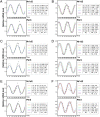Noninvasive method for assessing the human circadian clock using hair follicle cells
- PMID: 20798039
- PMCID: PMC2932591
- DOI: 10.1073/pnas.1003878107
Noninvasive method for assessing the human circadian clock using hair follicle cells
Abstract
A thorough understanding of the circadian clock requires qualitative evaluation of circadian clock gene expression. Thus far, no simple and effective method for detecting human clock gene expression has become available. This limitation has greatly hampered our understanding of human circadian rhythm. Here we report a convenient, reliable, and less invasive method for detecting human clock gene expression using biopsy samples of hair follicle cells from the head or chin. We show that the circadian phase of clock gene expression in hair follicle cells accurately reflects that of individual behavioral rhythms, demonstrating that this strategy is appropriate for evaluating the human peripheral circadian clock. Furthermore, using this method, we indicate that rotating shift workers suffer from a serious time lag between circadian gene expression rhythms and lifestyle. Qualitative evaluation of clock gene expression in hair follicle cells, therefore, may be an effective approach for studying the human circadian clock in the clinical setting.
Conflict of interest statement
The authors declare no conflict of interest.
Figures




References
Publication types
MeSH terms
Substances
Grants and funding
LinkOut - more resources
Full Text Sources
Other Literature Sources

